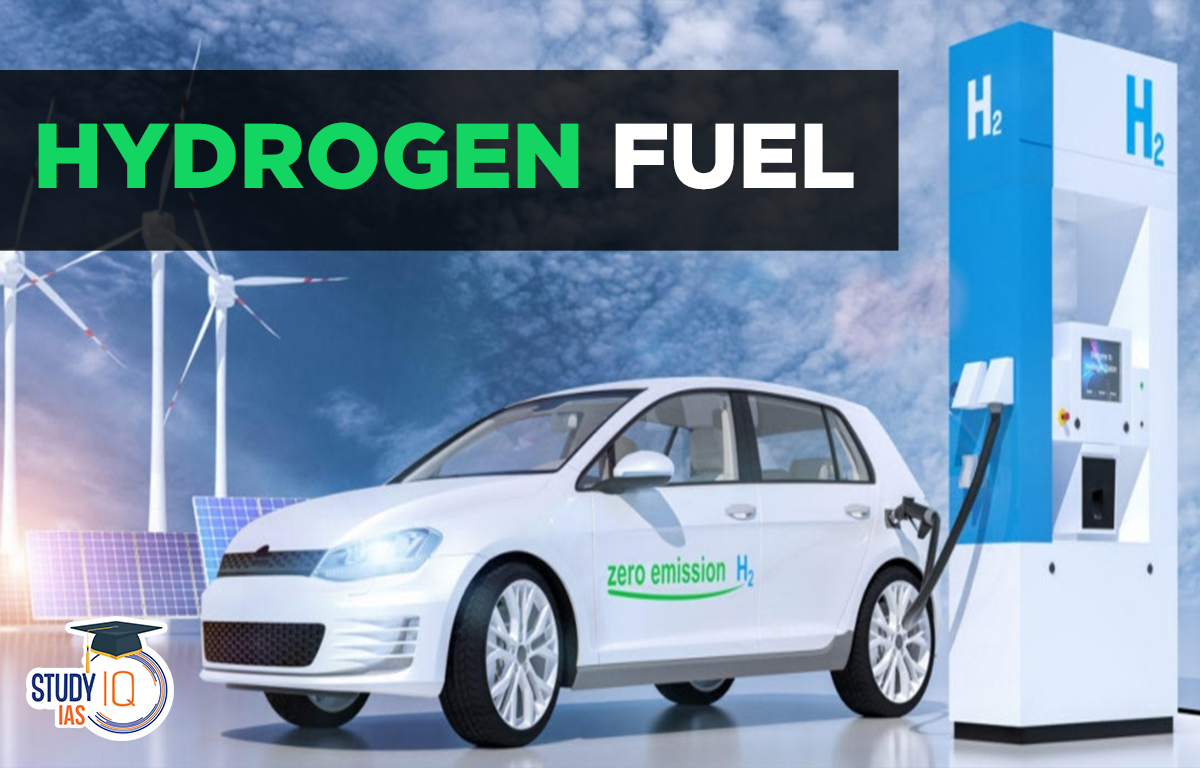Table of Contents
Context: Hydrogen Fuel: Four studies published this year say hydrogen loses its environmental edge when it seeps into the atmosphere.
Highlights of the Hydrogen Fuel Study
- Leakages of Hydrogen: Scientists involved has expressed their concern over leakages of Hydrogen.
- If 10% leaks during hydrogen production, transportation, storage, or use, the benefits of using green hydrogen over fossil fuels would be completely wiped out.
- Hydrogen when leaks into the atmosphere, reduces the concentration of molecules that destroy the greenhouse gases already there, potentially contributing to global warming.
- It estimates that leakage rates could reach up to 5.6% by 2050 when hydrogen is being used more widely.
- Carbon Emitter: Hydrogen used now in oil refineries, chemicals factories and the fertiliser industry is made from natural gas in a process that produces carbon dioxide.
- Safety Concern: Hydrogen is far more explosive than natural gas which could create safety issues.
- Data Gap: There is a Lack of technology for monitoring hydrogen leaks.
- Thus, research is needed to calculate its net impact on global warming before final investment decisions are taken.
- Slow Pace of Growth: Green hydrogen would need to meet about 12% of the world’s energy demand by 2050 to achieve Paris climate targets.
- However, based on the current pace of development, world is only on track to reach about 4% target.
About Hydrogen
- Hydrogen is a colourless, odourless, tasteless, non-toxic and highly combustible gaseous substance.
- It is the lightest, simplest and most abundant member of the family of chemical elements in the universe.
Types of Hydrogen

Advantages of Hydrogen
- Renewable and Readily Available: Hydrogen is the most abundant element in the Universe. It is a Clean and Flexible Energy Source to support Zero-Carbon Energy Strategies
- Powerful and Energy Efficient than Fossil Fuels: Hydrogen fuel cell technology provides a high-density source of energy with good energy efficiency. Hydrogen has the highest energy content of any common fuel by weight.
- Almost Zero Emissions: Hydrogen fuel cells do not generate greenhouse gas emissions as for fossil fuel sources, thus reducing pollution and improving air quality as a result.
- Reduces Carbon Footprints: With almost no emissions, hydrogen fuel cells do not release greenhouse gases, which means they do not have a carbon footprint while in use.
- Fast Charging Times: The charge time for hydrogen fuel cell power units is extremely rapid, similar to that for conventional internal combustion engine (ICE) vehicles and markedly quicker in comparison to battery-powered electric vehicles.
- Use in Remote Areas: Where local conditions allow, the availability of hydrogen through local generation and storage could prove to be an alternative to diesel-based power and heating in remote areas.
- Democratization of Power Supply: Hydrogen fuel cells have the potential to reduce the dependency of a nation on fossil fuels, which will help democratise energy and power supplies around the world.
- Grid stability: The intermittent nature of renewable energy, especially wind, leads to grid instability. But, green hydrogen can be stored for long periods of time which can be used to produce electricity using fuel cells.
Disadvantages of Hydrogen
- Hydrogen Extraction: Despite being the most abundant element in the Universe, hydrogen does not exist on its own so needs to be extracted from water via electrolysis or separated from carbon fossil fuels.
- High Investment: Hydrogen fuel cells need investment to be developed to the point where they become a genuinely viable energy source.
- Cost of Raw Materials: Precious metals such as platinum and iridium are typically required as catalysts in fuel cells and some types of water electrolyser, which means that the initial cost of fuel cells (and electrolysers) can be high.
- Hydrogen Storage: Storage and transportation of hydrogen is more complex than that required for fossil fuels. This implies additional costs to consider for hydrogen fuel cells as a source of energy.
- Infrastructure: Large scale adoption of hydrogen fuel cell technology for automotive applications will require new refueling infrastructure to support it, although for long-range applications such as those for HGVs and delivery truck the start-to-end refueling will be used.
- Highly Flammable: Hydrogen is a highly flammable fuel source, which brings understandable safety concerns. Hydrogen gas burns in air at concentrations ranging from 4 to 75%.
Green Hydrogen and India
- Green hydrogen is produced through electrolysis using renewable sources of energy such as solar, wind or hydel power.
- India has begun to generate green hydrogen with the objective of raising non-fossil energy capacity to 500 gigawatts by 2030.
- National Hydrogen Mission was launched on August 15, 2021, with a view to cutting down carbon emissions and increasing the use of renewable sources of energy.
- On April 20, India’s first 99.99% pure green hydrogen pilot plant was set up in eastern Assam’s Duliajan.
Significance of India Pursuing Green Hydrogen
- Under the Paris Agreement of 2015, India is committed to reducing its greenhouse gas emissions by 33-35% from the 2005 levels.
- At the 2021 Conference of Parties in Glasgow, India reiterated its commitment to move from a fossil and import-dependent economy to a net-zero economy by 2070.
- India’s average annual energy import bill is more than $100 billion and the increased consumption of fossil fuel has made the country a high carbon dioxide (CO2) emitter, accounting for nearly 7% of the global CO2 burden.
- In order to become energy independent by 2047, the government stressed the need to introduce green hydrogen as an alternative fuel that can make India the global hub and a major exporter of hydrogen.
Way Forward
- Research: More research has to be conducted on hydrogen’s warming effects relative to other greenhouse gases.
- Measuring the leakages: Currently, there is no sufficient data on hydrogen leakages. We need much better devices to measure the leakage, and regulations which actually enforces the measurement of the leakage.
- Leakage mitigation measures: Lessons learned over the past decade about minimizing natural gas leakage can help, despite the differences in the properties of these two gases.
- Climate metrics: Use of climate metrics that reflect the role that hydrogen leakage could play over the policy-relevant near-term, instead of relying exclusively on 100-year accounting.


 UPPSC RO ARO Exam Date 2025 Out: Typing ...
UPPSC RO ARO Exam Date 2025 Out: Typing ...
 Maharashtra Bill to Curb Urban Naxalism,...
Maharashtra Bill to Curb Urban Naxalism,...
 International Maize and Wheat Improvemen...
International Maize and Wheat Improvemen...





















